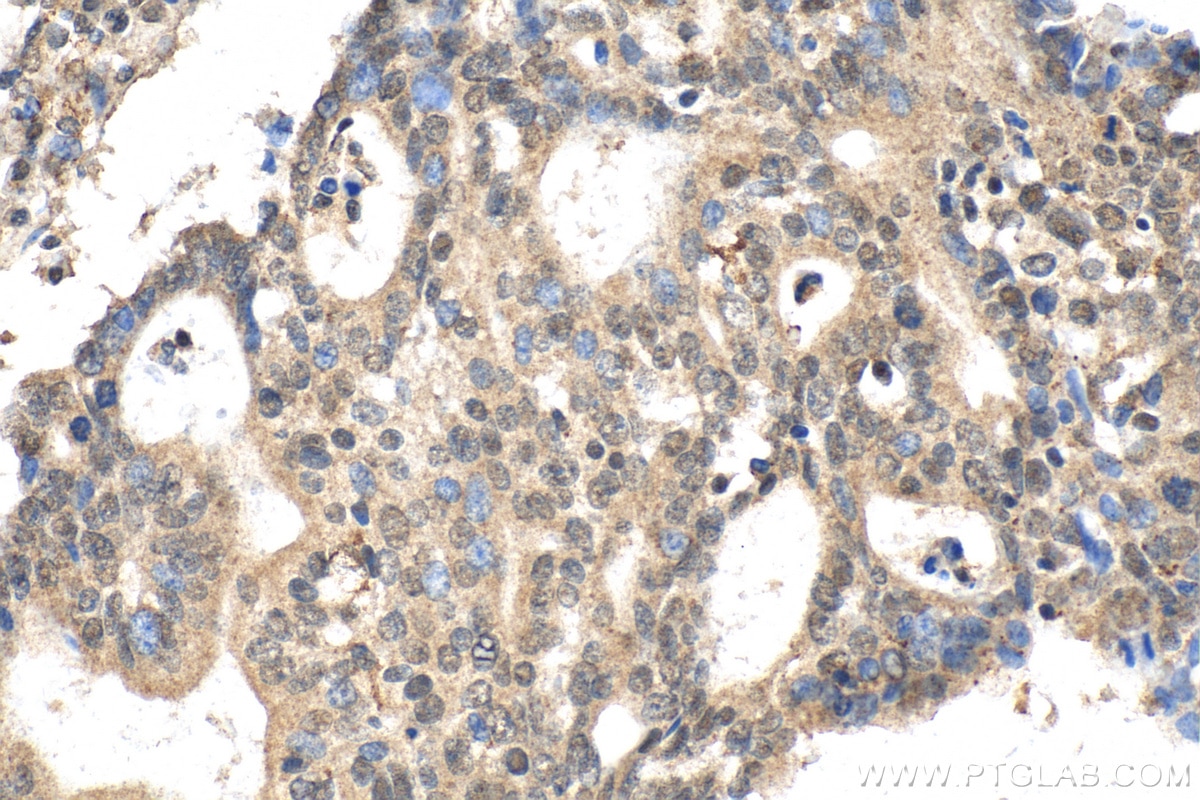- Phare
- Validé par KD/KO
Anticorps Polyclonal de lapin anti-YPEL3
YPEL3 Polyclonal Antibody for WB, IHC, ELISA
Hôte / Isotype
Lapin / IgG
Réactivité testée
Humain, rat, souris
Applications
WB, IF, IHC, ELISA
Conjugaison
Non conjugué
N° de cat : 15403-1-AP
Synonymes
Galerie de données de validation
Applications testées
| Résultats positifs en WB | cellules BxPC-3, |
| Résultats positifs en IHC | tissu de cancer de l'endomètre humain, il est suggéré de démasquer l'antigène avec un tampon de TE buffer pH 9.0; (*) À défaut, 'le démasquage de l'antigène peut être 'effectué avec un tampon citrate pH 6,0. |
Dilution recommandée
| Application | Dilution |
|---|---|
| Western Blot (WB) | WB : 1:500-1:2000 |
| Immunohistochimie (IHC) | IHC : 1:50-1:500 |
| It is recommended that this reagent should be titrated in each testing system to obtain optimal results. | |
| Sample-dependent, check data in validation data gallery | |
Applications publiées
| KD/KO | See 1 publications below |
| WB | See 3 publications below |
| IHC | See 1 publications below |
| IF | See 1 publications below |
Informations sur le produit
15403-1-AP cible YPEL3 dans les applications de WB, IF, IHC, ELISA et montre une réactivité avec des échantillons Humain, rat, souris
| Réactivité | Humain, rat, souris |
| Réactivité citée | Humain |
| Hôte / Isotype | Lapin / IgG |
| Clonalité | Polyclonal |
| Type | Anticorps |
| Immunogène | YPEL3 Protéine recombinante Ag7626 |
| Nom complet | yippee-like 3 (Drosophila) |
| Masse moléculaire calculée | 14 kDa |
| Poids moléculaire observé | 14 kDa |
| Numéro d’acquisition GenBank | BC005009 |
| Symbole du gène | YPEL3 |
| Identification du gène (NCBI) | 83719 |
| Conjugaison | Non conjugué |
| Forme | Liquide |
| Méthode de purification | Purification par affinité contre l'antigène |
| Tampon de stockage | PBS avec azoture de sodium à 0,02 % et glycérol à 50 % pH 7,3 |
| Conditions de stockage | Stocker à -20°C. Stable pendant un an après l'expédition. L'aliquotage n'est pas nécessaire pour le stockage à -20oC Les 20ul contiennent 0,1% de BSA. |
Informations générales
YPEL3 is part of a five-member family of closely related paralogues: YPEL1-5, which are named in reference to their Drosophila ortholgue. Studies showed shat YPEL3 is regulated by p53 and its encoding protein induces cellular senescence in human tumor and normal cells, indicating that YPEL3 is a p53-dependent, tumor suppressor gene. (PMID:20388804) 15403-1-AP was raised against full length of YPEL3 protein (1-119aa); it can recognize YPEL1-4.
Protocole
| Product Specific Protocols | |
|---|---|
| WB protocol for YPEL3 antibody 15403-1-AP | Download protocol |
| IHC protocol for YPEL3 antibody 15403-1-AP | Download protocol |
| Standard Protocols | |
|---|---|
| Click here to view our Standard Protocols |
Publications
| Species | Application | Title |
|---|---|---|
Int J Cancer Novel senescence associated gene, YPEL3, is repressed by estrogen in ER+ mammary tumor cells and required for tamoxifen-induced cellular senescence. | ||
Sci Rep Steroid sulfatase deficiency causes cellular senescence and abnormal differentiation by inducing Yippee-like 3 expression in human keratinocytes. | ||
Front Genet Identification of a cellular senescence-related-lncRNA (SRlncRNA) signature to predict the overall survival of glioma patients and the tumor immune microenvironment |




